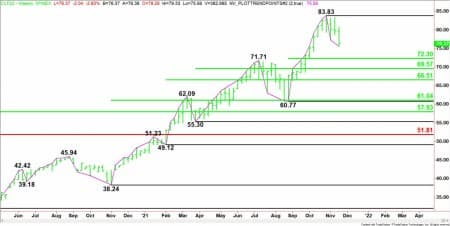U.S. West Texas Intermediate crude oil futures are trading lower on Friday after breaking sharply from their intraday highs earlier in the session. Weighing on prices were concerns that a fresh surge in COVID-19 cases in Europe would threaten to slow the economic recovery. A jump in the U.S. Dollar also weighed on demand forecasts while a potential release of crude reserves by major economies raised concerns over too much supply.
Perhaps contributing to the early volatility is the expiration of the December WTI futures contract and the rollover into the January WTI futures contract.
Fresh Concerns Over European Economic Recovery as Austria Reimposes Full Lockdown
Austria will become the first country in western Europe to reimpose a full coronavirus lockdown this autumn to tackle a new wave of infections, and will require its whole population to get vaccinated as of February, the government said on Friday.
With cold weather setting in across Europe, governments have been forced to consider reimposing unpopular lockdowns against continued COVID-19 contagion. Austria introduced a lockdown for those who are not fully vaccinated on Monday but since then infections have continued to set new records. The Netherlands is now in partial lockdown with bars and restaurants closing at 01:00 GMT.
With new COVID-19 cases expected to spread throughout Europe, crude oil traders are already starting to price in the possibility of demand destruction due to economic…
U.S. West Texas Intermediate crude oil futures are trading lower on Friday after breaking sharply from their intraday highs earlier in the session. Weighing on prices were concerns that a fresh surge in COVID-19 cases in Europe would threaten to slow the economic recovery. A jump in the U.S. Dollar also weighed on demand forecasts while a potential release of crude reserves by major economies raised concerns over too much supply.
Perhaps contributing to the early volatility is the expiration of the December WTI futures contract and the rollover into the January WTI futures contract.
Fresh Concerns Over European Economic Recovery as Austria Reimposes Full Lockdown
Austria will become the first country in western Europe to reimpose a full coronavirus lockdown this autumn to tackle a new wave of infections, and will require its whole population to get vaccinated as of February, the government said on Friday.
With cold weather setting in across Europe, governments have been forced to consider reimposing unpopular lockdowns against continued COVID-19 contagion. Austria introduced a lockdown for those who are not fully vaccinated on Monday but since then infections have continued to set new records. The Netherlands is now in partial lockdown with bars and restaurants closing at 01:00 GMT.
With new COVID-19 cases expected to spread throughout Europe, crude oil traders are already starting to price in the possibility of demand destruction due to economic slowdowns.
Strong US Dollar Weighs on Foreign Demand
The U.S. Dollar was trading higher against a basket of major currencies on Friday, led by a plunge in the Euro. Since crude oil is a dollar-denominated asset, the rise in the greenback dampened demand from holders of foreign currencies.
The Euro is trading sharply lower against the U.S. Dollar on Friday after European Central Bank President Christine Lagarde said that inflation in the Euro Zone will fade so the ECB should not tighten policy as it could choke off the recovery, and hinted at continued bond purchases next year, Reuters reported.
“When inflation pressure is expected to fade – as is the case today – it does not make sense to react by tightening policy,” she said. “The tightening would not affect the economy until after the shock has already passes.”
Threat of Increased Supply Weighing on Sentiment
The threat of rising supply is also contributing to the drop in crude oil prices, but not as much as the media thinks.
According to Reuters, the Biden administration on Wednesday asked some of the world’s largest consuming nations – including China, India and Japan – to consider releasing crude oil prices in a move they think will pressure prices.
Although prices fell in response to the news, there are some who believe the move was politically motivated and in retaliation to OPEC+’s rebuffing of repeated requests from Washington to speed up their production increases.
“We’re talking about the symbolism of the largest consumers of the world sending a message to OPEC that ‘you’ve got to change your behavior,” one of the sources told Reuters.
An Unprecedented Challenge to OPEC
The current proposal represents an unprecedented challenge to OPEC, the cartel that has influenced oil prices for more than five decades, because it involves China, the world’s biggest importer of crude.
According to the latest report from Reuters, China’s state reserve bureau said it was working on a release of crude oil reserves although it declined to comment on the U.S. request.
Meanwhile, there could be a problem in Japan. According to Reuters, a Japanese industry ministry official said the United States has requested Tokyo’s cooperation in dealing with higher oil prices, but he could not confirm whether the request included coordinated releases of stockpiles. By law, Japan cannot use reserve releases to lower prices, the official said.
Weekly Technical Analysis
Weekly January WTI Crude Oil

Trend Indicator Analysis
The main trend is up according to the weekly swing chart. However, momentum shifted to the downside with the confirmation of the closing price reversal top from the week-ending October 29.
A trade through $83.83 will negate the closing price reversal top and signal a resumption of the downtrend. A move through $60.77 will change the main trend to down.
The minor trend is down. The minor trend changed to down this week when sellers took out the minor bottom at $77.23. The move confirmed the shift in momentum to down.
Retracement Level Analysis
The minor range is $60.77 to $83.83. The market is currently trading on the strong side of its 50% level at $72.30, making it the nearest support.
The short-term range is $55.30 to $83.83. Its 50% level at $69.57 is the best support. This price is controlling the near-term direction of the market.
Additional support levels come in at $66.51, $61.04 and $57.93 to $51.81.
The retracement zone targets will move up as the market moves higher.
Weekly Technical Forecast
The direction of the December WTI crude oil market the week-ending November 26 will be determined by trader reaction to $79.69.
Bullish Scenario
A sustained move over $79.69 will indicate the presence of buyers. If this move is able to generate enough upside momentum then look for a possible surge into $83.83. This is a potential trigger point for an acceleration to the upside.
Bearish Scenario
A sustained move under $79.69 will signal the presence of sellers. This could create the downside momentum needed to complete a 50% correction of the August to October rally at $72.30.
Short-Term Outlook
If Biden thinks he can rally other countries to release enough oil to lower prices for a prolonged period of time, then he should fire his advisor. These countries along with the United States are releasing oil that is supposed to be used for emergency purposes. Since this is not a real emergency, the releases will be limited.
Furthermore, if prices fall too far, too fast then OPEC and its allies will just stop increasing production to the tune of 400,000 barrels per day like they have pledged.
In my opinion, all of the news this week is short-term bearish. As long as crude oil demand continues to rebound faster than supply, prices will remain underpinned. But the market could become oversupplied quite quickly
All of this could change if OPEC is right in its forecast that cut world oil demand for the fourth quarter by 330,000 barrels per day (bpd) from last month’s forecast due to high energy prices that could hamper recovery from the economic fallout from the COVID-19 pandemic.
Furthermore, COVID-driven demand destruction in Europe could help fulfill OPEC’s prediction a lot faster than anticipated.
If demand drops enough, OPEC and its allies may decide to pause their plan to increase output by 400,000 bpd. If they don’t make the move then oil supply could surge again, putting pressure on prices during the first quarter of 2022.
Buyers may be looking for the “sweet” spot on the chart to reestablish long positions. This could be $72.30 this week.
